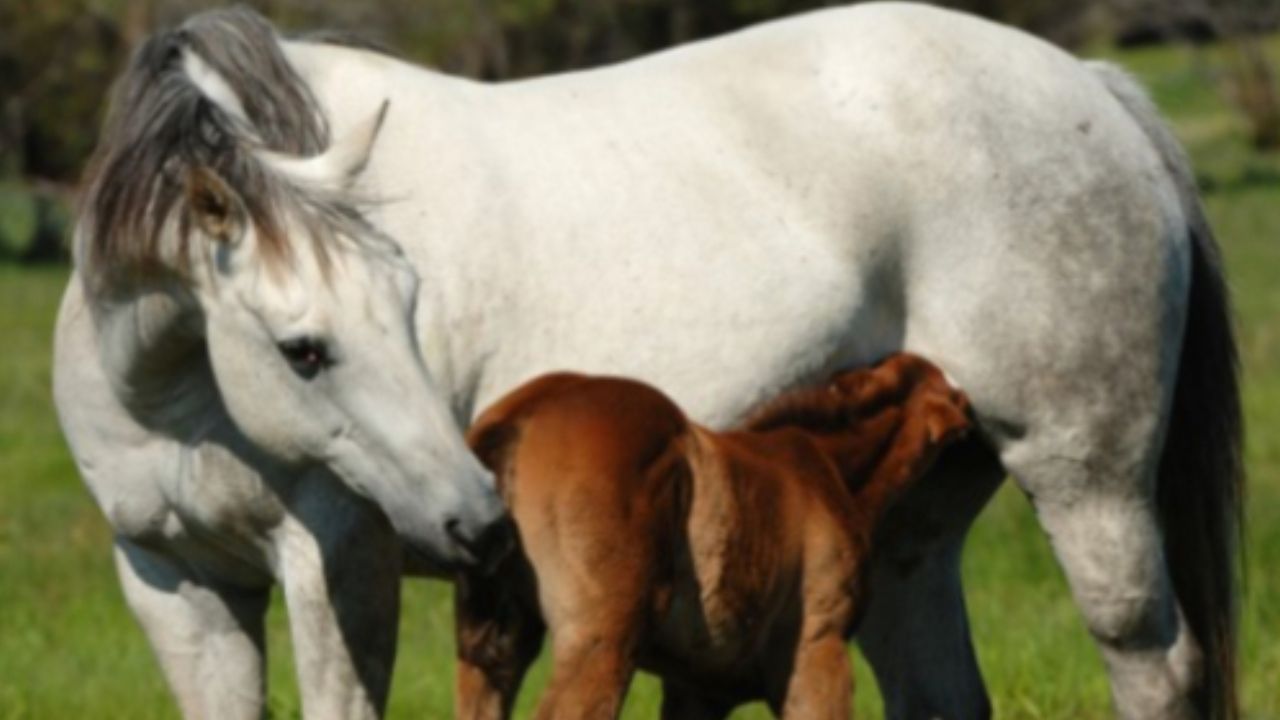Mares & Foals
Image - EquiNatural's 18yo TB mare, Carmen, Summer 2024
© EquiNatural 2025. Written by Carol Moreton, EquiNatural's founder. All content is original work protected under copyright, and may not be re-published, duplicated, or rewritten for commercial use without permission.
Content
- Intro
- Keeping our mares happy
- The pregnant mare
Sub Chapters
- Creating the foal's microbiome
- Feeding the young horse
Principal Body System: Reproductive
Definition: The mechanism by which the thread of life is sustained. Organs (ovaries) that produce
reproductive cells and other organs that transport and store reproductive cells.
Function: Reproduces the organism.
In natural horse-world, mare-ness is completely normal, but for us human caretakers, half a ton of domesticated girl with hormonal attitude can be, shall we say, interesting.
Mares are seasonally polyestrus creatures. This means they undergo hormonal cycles during certain seasons of the year (spring, summer and autumn), but not usually during the winter months, which some say is nature's way of preventing the arrival of a foal during bad weather. Most mares will have 21-day equine estrous cycles, which is the duration of time between each ovulation.
A mare will remain in estrous, or in season, for 3 to 5 days each time, as part of the overall equine estrous cycle. Known as the follicular phase of the estrous cycle, this is the period where the mare is fertile for breeding, which ultimately is what nature is intending.
A quick reminder here of the Circadian Rhythm - this is the 24-hr life cycle in the physiological process of all living beings, determining sleeping/feeding patterns, brainwave activity, hormone production, cell regeneration and other biological activities. Horses live in these very rhythms of nature, which means their physical, emotional and mental health respond to the changes between the seasons, and change according to the cycles of light and dark, sunlight and temperature.
Mares know exactly when Spring arrives – as the days get longer, their sex hormones respond (the estrous cycle), and one of the big behavioural messages their hormones start telling them to do is to find a mate. Typical seasonal behaviour throughout the breeding season to be translated as unpredictable, everything from moody and distracted to plain mean and aggressive!
However, an interesting point. Consider our wild mares – they live in the company of a permanent herd with a stallion, they come into season in early spring, they mate, they’re then in-foal for 11 months, they foal, they nurse, then before you know it Spring come back round and it's time to seek out the best stallion to produce the best babies.
This is how it's meant to be, and for our wild mares their year from Spring to Spring usually involves only one season - the rest of the time they're busy doing what nature intended for them, and the physiological state that causes typical menstrual symptoms simply doesn't occur.
Our domestic non-broodmare pets, however, are neither in the company of stallions in Spring, nor are in foal for the entirety of the summer, autumn and winter. So, factor in a continuous rolling 21-day estrous cycle throughout the spring/summer, which in nature they're not really meant to experience, plus all the day-to-day changes in a domestic regime (workouts/exercise, performance/competition, stabling, restricted turnout, feed and management changes, horse companions moving on), and it’s no wonder that hormones are disrupted.
Nature expects only one or two fertile seasons, followed by pregnancy, birth, and nursing. The more seasons our mares have without a pregnancy, the more chance there is that they will have seasonal behaviour that us humans consider challenging.
For most of our domestic mares, they also have either very limited, or no access to any male horses. In any domestic herd, a horse will take on the role of boss, and in our mixed domestic herds, either a gelding or mare will take on the role. It doesn’t necessarily mean bullying the herd; it’s more about keeping the herd safe, dealing with intruders, moving the herd, standing guard while others sleep and so on. The mares will soon recognise that the geldings in their herds aren’t behaving like stallions, and leave them alone after a while.
However, come spring, and the sex-drive hormones are apparently so strong in mares that she will actively search for a stallion - rather than being a wallflower she’ll check out every new gelding she meets, and very often that gelding will be able to bring her into season unexpectedly. It's also a myth that unexpected matings are caused by stallions gatecrashing after midnight - statistics show that mares kept in same-gender herds escape more often in search of a stallion, compared to their mixed-herd peers, rather than escaped stallions finding mares.
Keeping our mares happy
We don't want to change the natural process; we just want our non-breeding mare to be more comfortable during her seasons, and thus more manageable for us. I don’t think there’s any doubt that keeping her in a more natural way in a mixed herd will enormously benefit her biorhythms. Keep the herd constant so she remains settled, and this will have a really positive effect on her seasonal responses.
However, we can only work within the environment that we have, and there is a bounty of natural herbs to support our mares through their uncomfortable times and take the edge off.
- The filly A young filly just coming into season for the first time can benefit greatly from herbs. Her cycle can sometimes be a bit hit-and-miss to start with, but this is usually nothing to worry about – just minor hormone imbalances, and they can be helped with the mildest of gentle herbs. If your girl is still experiencing imbalances past the age of 5, then you can move her onto a more effective blend. It might be worth a vet check though, just to rule out anything that might actually be causing the imbalances.
- The PMS mare Now we’re at age 5 onwards, through to around 15. Her cycles are now fairly regular but can have a large assortment of issues ranging from mild to severe cramping, lethargy and depression, aggressiveness, attitude problems, lack of concentration, and more. It's not all bad news though - keep her supported on a regular and continuous basis, and you'll see a happier mare. Sometimes feeding the mare a good liver/kidney detox blend every few months can also help alleviate hormone imbalances.
- The menopausal mare Now our girl has reached her senior years, her hormonal needs are changing and her supplementation will need changing, just as it does for us. Also helpful to the older mare is a good immunity blend, specifically tonic herbs.
The pregnant mare
Preparing a mare for breeding should begin long before she is introduced to the stallion. Mares should be kept in good physical shape, receiving optimum nutrition, ample exercise and turnout, and regular hoof and dental care. After the mare has been covered by the stallion, herbs should be stopped immediately until an ultrasound has been performed. If the mare is not in foal, the blend may be resumed again, but always stop any herbal preparations once the mare has been covered. Supplements of any kind should always be fed with caution to the pregnant mare.
Once a mare is in foal, there are only a few select herbs that are recommended, and then only during the last 75 days of pregnancy. Any herb that may stimulate the uterus should be avoided during the pregnancy, such as black cohosh, blue cohosh, motherswort, and yarrow. Steer clear from garlic during the last 30 days as it may taint the milk.
Raspberry leaf is the ultimate pregnancy herb. It tones the uterine muscles and is very high in vitamins and minerals. It will also help with increased milk production. Feeding raspberry leaf during the last 45 days of a pregnancy is thought to help the mare during delivery, with success noted for mares with chronic delivery type problems (eg, prolonged delivery, retained placenta, little or no milk production, excessive bleeding during delivery).
* IMPORTANT - As as precaution, the following is a list of herbs that should never be fed to mares during gestation:
~ agnus castus vitex berries, angelica, ashwagandha, barberry, black cohosh, blue cohosh, blessed thistle, Bloodroot (VERY DANGEROUS), buchu, catnip, coltsfoot, devil's claw, dong quai root, elecampane root, false unicorn root, garlic, ginger, goldenseal, horehound, juniper berries, liquorice, lobelia, lycii berries, maidenhair (ginkgo), motherwort, mugwort, osha root, parsley, pennyroyal, prickly ash bark, queen of the meadows, red clover, rue, sage, sassafras root, shepherds purse, tansy, uva ursi, wormwood, yarrow
After the foal is born, raspberry leaf is recommended to help the uterus get back into shape. Fennel and fenugreek are also very enriching and will aid in milk quality as well.
Click on the SHOP link below to see our Mares product range.
Blog Posts
Breeding and raising a foal
08 May, 2024
Breeding a foal can be an incredibly fulfilling experience for any horse owner, but there’s more to it than simply finding a handsome chap 😉

Naturally Balancing our Mares' Hormones
21 Jun, 2017
I’ve had quite a few enquiries recently from concerned owners struggling to help their ‘hormonal’ mares. Comments like “her hormones seem so out of balance”, “she gets so cross at everything”, “unpredictably explosive”, and “seriously considering Regumate”, are all too familiar.
Food for thought eh?


